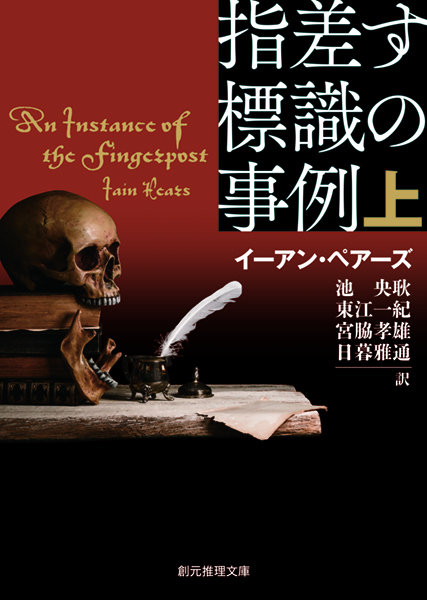【第8回】コンシェルジュ河出の世界文学よこんにちは『指差す標識の事例 上・下』イーアン・ペアーズ/東京創元社
「信頼できない語り手」たちが語るたった一つの事件 『指差す標識の事例 上・下』
時は一六六三年、ヴェネツィアの貿易商の息子マルコ・ダ・コーラは、父の商売上の問題を処理するためイングランドに赴き、そこで友を得、激しい気性の女性と出会い、不可解な殺人と遭遇する…
「指差す標識の事例」はこのようにして始まる。
この第一部は、イングランドとヴェネツィアとのカルチャーギャップに触れて時折イングランドをこきおろしたりもするけれど、基本的に気のいいコーラが異国で遭遇した出来事を彼の視点から描いている。現代人ゆえの医学的知識から「ああっ、××なしで○○なんてしたら……!」などとどきどきしたり、当時の人々の生活風俗を興味深く眺めたりしながら、この一編だけでも楽しめるだろう。「本当にこれで終わりなのだろうか」と疑問を抱きながらも。
この本が面白くなるのは第一部が幕を下ろし第二部が始まってからだ。第二部で読者は、一見裏表のない好漢に見えた第一部の語り手コーラに実は語らずに済ませていたことがあり、またコーラのあずかり知らないところで展開していたために第一部には当然含まれていないもう一つの物語があったことを、第一部にも登場した人物が語るのを聞くことになる。またこの第二部の語り手は第一部にあたるコーラの手記を読んでおり、手記の内容に一部疑念を示しているのだ。そう、ミステリーファンが大好きな「信頼できない語り手」の要素がここで差しはさまれる。更に第三部では、新たな語り手が第一部、第二部を読んだ上で己の体験した一連の出来事を振り返り、第一部、第二部を読んだ上で築かれてきた様々な登場人物の人物像が、新たな語り手の目から見られることによってまた新しい光を当てられ、変容していく様を読者は目の当たりにすることになる。更に更に第四部では、第三部の語り手ももちろん、他人の目に晒され評価されることを免れない。
「指差す標識の事例」の面白さは、一つにはこの構造にあると思う。物語をめぐる主な登場人物を紹介し、中心となる事件の顛末を述べる第一部はいわば「問題篇」だ。「問題篇」ではあるのだけれど、この「問題篇」は「解決篇」でもある。とりあえず物語に決着はつくからだ。じゃあ第二部、第三部が「真の解決篇」かと言うと、そうも言えない。いや、それぞれの語り手にとってはそれが「真の解決篇」なのだが、彼らが「真の解決篇」として書いているそれは、実は何層にも連なった地層の一つに過ぎず、彼らはあくまで自分の視点からしか物を見ることができないために、実は自分が見ていない層が外側に存在することを知らないのだ。読者がすべてを知っている人物に出会うには、第一部から第三部を読んだ上で書かれた「真の解決篇」、第四部を待たねばならない。
この語りの構造ゆえに、第二部を読むと一体第三部ではどんな「見せられていなかったこと」が語られるのかと先を読みたくなること必至である。もちろん、すべての謎が明かされる第四部なんてもう、読まずにはいられない。そしてこの第四部がとにかく面白い。三つのこれまで語られてきた三つの物語のあれやこれやに、力業ではなく端正な結末をつけてくれるだけでなく、ラスト数ページにまで最後の仕上げとばかりに驚きの真相を仕込む周到さには脱帽するしかない。末永く名作として読まれてほしい本だ。
今回ご紹介した書籍
イーアン・ペアーズ・著
池 央耿、東江 一紀、宮脇 孝雄、日暮 雅通・訳
東京創元社
イーアン・ペアーズ・著
池 央耿、東江 一紀、宮脇 孝雄、日暮 雅通・訳
東京創元社



